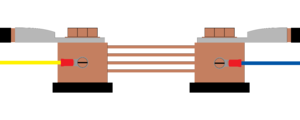Difference between revisions of "Shunt/es"
(Created page with "File:Shunt.png|thumb|right|Un shunt conectada en serie con un cable negativo de batería. Un shunt también requiere dos cables sensores de voltaje adicionales (conectados a...") |
(Created page with "Un shunt es un dispositivo que se coloca en serie en un circuito que permite medir el flujo de corriente. Un shunt tendrá una resis...") |
||
| Line 3: | Line 3: | ||
[[File:Shunt.png|thumb|right|Un shunt conectada en serie con un cable negativo de batería. Un shunt también requiere dos cables sensores de voltaje adicionales (conectados al costado del shunt).]] | [[File:Shunt.png|thumb|right|Un shunt conectada en serie con un cable negativo de batería. Un shunt también requiere dos cables sensores de voltaje adicionales (conectados al costado del shunt).]] | ||
| − | + | Un shunt es un dispositivo que se coloca en [[Special:MyLanguage/Series and parallel|serie]] en un circuito que permite medir el flujo de corriente. Un shunt tendrá una resistencia definida muy baja que crea una pequeña cantidad de [[Special:MyLanguage/Voltage drop|caída de tensión]] de un lado del shunt al otro, que se puede utilizar para determinar la cantidad de corriente que fluye. Puede ser difícil obtener una medición precisa del [[Special:MyLanguage/Energy storage#State of charge (SOC)|estado de carga (SOC)]] de un banco de baterías que solo usa voltaje. Una derivación es muy útil en un sistema FV autónomo, ya que permite que un controlador de carga calcule el estado de carga de un banco de baterías con mayor precisión. El estado de carga calculado generalmente está disponible para los usuarios a través del controlador de carga o un sistema de monitoreo para permitirles ajustar su consumo de energía en consecuencia. En sistemas más grandes en los que se integran controladores de carga, inversores y generadores, la información también se puede utilizar para controlar cómo funcionan el inversor y el generador. El tipo de shunt más comúnmente utilizado tiene una capacidad de hasta 500 A y tiene una resistencia de .0001 Ω (ohmios) o 100 µΩ (microohmios). Esta configuración producirá una caída de voltaje de 1 mV por 10 A de corriente. | |
The calculation that is performed to determine the amount of current flowing in a circuit uses Ohm's Law: | The calculation that is performed to determine the amount of current flowing in a circuit uses Ohm's Law: | ||
Revision as of 11:57, 11 February 2021
Un shunt es un dispositivo que se coloca en serie en un circuito que permite medir el flujo de corriente. Un shunt tendrá una resistencia definida muy baja que crea una pequeña cantidad de caída de tensión de un lado del shunt al otro, que se puede utilizar para determinar la cantidad de corriente que fluye. Puede ser difícil obtener una medición precisa del estado de carga (SOC) de un banco de baterías que solo usa voltaje. Una derivación es muy útil en un sistema FV autónomo, ya que permite que un controlador de carga calcule el estado de carga de un banco de baterías con mayor precisión. El estado de carga calculado generalmente está disponible para los usuarios a través del controlador de carga o un sistema de monitoreo para permitirles ajustar su consumo de energía en consecuencia. En sistemas más grandes en los que se integran controladores de carga, inversores y generadores, la información también se puede utilizar para controlar cómo funcionan el inversor y el generador. El tipo de shunt más comúnmente utilizado tiene una capacidad de hasta 500 A y tiene una resistencia de .0001 Ω (ohmios) o 100 µΩ (microohmios). Esta configuración producirá una caída de voltaje de 1 mV por 10 A de corriente.
The calculation that is performed to determine the amount of current flowing in a circuit uses Ohm's Law:
| Voltage (V) | = current (I) × resistance (R) |
|---|
If two variables for a circuit are known, the third can be calculated using Ohm's Law. In the case of a shunt, resistance and voltage are known variables. The formula can be rearranged to solve for current.
| Current (I) | = voltage (V) ÷ resistance (R) |
|---|
Example 1: A 12 V DC circuit has a voltage of 12.5V and it is passing through a shunt with a .0001 Ω rated resistance. The voltage reading on the other side of the shunt is 12.497 V. How much current is flowing in the circuit?
Voltage drop in shunt = 12.5 V - 12.497 V = .003 V
- I = .003 V ÷ .0001 Ω
- I = 30 A
